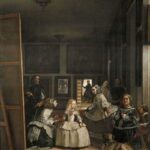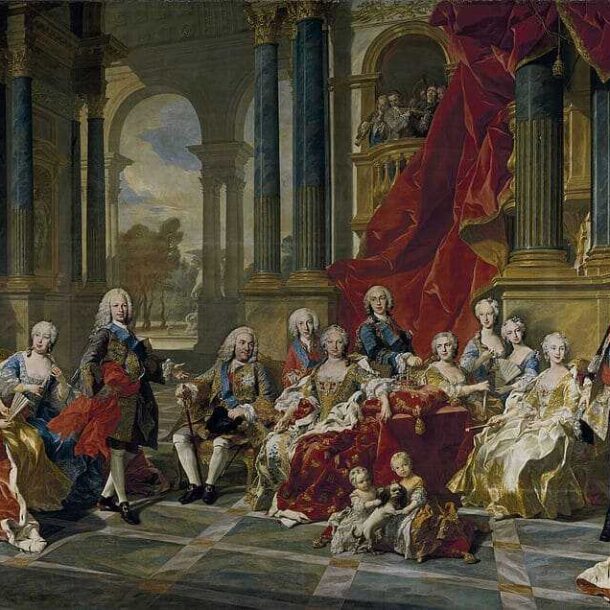
Las Meninas is one of the most important works in the history of art because it is a creation, with a complex composition that conveys a sense of life and reality, and at the same time contains various meanings. Palomino notes that it was painted in 1656 in the Prince’s Room of the Alcázar in Madrid. Palomino identified most of the figures as palace servants who were arranged around the Infanta Margarita. She is attended by María Agustina Sarmiento and Doña Isabel de Velasco, the queen’s meninas. Next to the small central group is Diego de Velázquez working in front of a canvas on the left-hand margin and, on the right-hand margin, the dwarves Mari Bárbola and Nicolasito Pertusato, who is whipping a mastiff, together with the lady-in-waiting Marcela Ulloa. In the background, the aposentador José Nieto appears. Philip IV and Mariana of Austria, the Infanta’s parents and witnesses to the scene, are reflected in the mirror in the background, where a scientific, aerial perspective with important sources of light prevails. The presence of the mirror in the background of the composition turns the painting into a reflection on the act of seeing and makes the viewer wonder about the laws of representation, about the limits between painting and reality, and about the role within the painting. In addition to this, a series of considerations occupy the viewer, mainly in response to the question of what role he or she plays in the composition. On the one hand, there is a court scene in which the Infanta is shown with a small group of courtiers. However, the question arises as to who the Sevillian master is depicting, the Infanta or the monarchs who are being observed in a group.
Collection: Images
Project: 4. Family, daily life and social inequality in Europe., 5. Power and powers in the history of Europe: oligarchies, political participation and democracy.
Chronology: XVII
Scope: Secondary Education, Baccalaureate, University
Resource type: Image
Format: Oil on canvas (320,5 x 281,5 cm)
Source: Museo Nacional del Prado (Madrid)
Language: Spanish
Date: 1656
Owner: Álvaro Romero González (Modernalia)
Identifier: P001174
Copyright: Museo del Prado (Madrid)
Abstract: A work by Velázquez depicting the family of Philip IV, which has become one of the most famous canvases in the history of art.
Image
Tags






